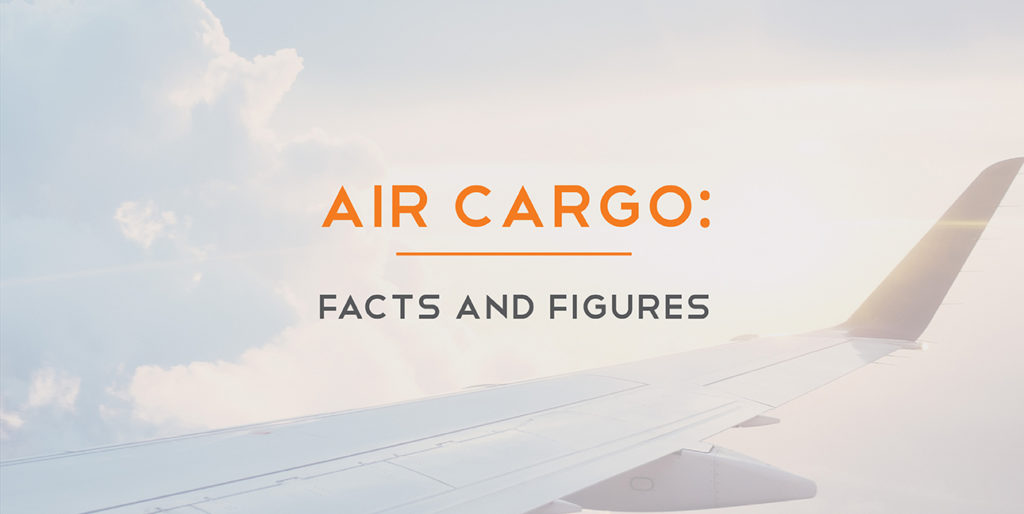Check out the updated version of this post here (April 14, 2022)
Air cargo, which is defined as any property transported or to be transported by an aircraft, has had a monumental impact on the world that we live in today since its origination in 1910. The ability to transport cargo across the globe in an efficient and timely manner has brought the world closer together through the exchange of otherwise unavailable goods.
35% of global trade by value is represented by air cargo, and revenue of cargo airlines amounted to around 50.7 billion U.S. dollars worldwide in 2017. Across the globe, there are 3,200 airports with 60,000 trade lanes, and an astonishing 68 million people have jobs supported by the aviation industry. Understanding the air transport industry, and it’s massive impact on the world, is an important factor when it comes to making informed logistics decisions.
There are many factors to look at when making the decision to use air transportation. While you may have to pay more to get goods delivered by air cargo, the advantages include speed, safety and security. Air cargo is relatively expensive, but often the fastest mode of transport.
To better understand the industry, it is important to start with some of the basic facts and figures of air cargo:
Most commonly transported cargo items
- Perishable goods: Perishable goods, like fruits, flowers and vegetables, need to be handled with care because of their sensitivity to time, extreme temperatures and humidity. Over 80,000 flowers are transported by air every single day.
- Pharma and healthcare: Over $1,000,000,000,000 worth of pharm cargo is moved every year, and 2.5 million lives are saved by the vaccines carried.
- Live animals: Carriage of live animals by air is considered one of the most humane and expedient methods of transportation over long distances.
- Dangerous goods: Given that certain items may endanger the safety of an aircraft or the person on board, transportation of certain dangerous materials can either be forbidden or restricted. Organizations like the IATA lead industry efforts to ensure safe handling of dangerous goods in air shipping.
- Electronics devices: Over 1.1 million smartphones are transported each day by air carrier. However, in the past two years alone, the total weight of laptops and tablets delivered by aircraft has fallen by 50%, primarily due to decreased size and weight of individual products.
- Postal parcels: 328 billion letters and 7.4 billion postal parcels are sent every year, and air mail plays an essential role in their on-time delivery.
*Data provided by the International Air Transport Association (IATA)
How much is carried?
According to the IATA, “In 2016, airlines transported 52 million metric tons of goods, representing more than 35% of global trade by value. That is equivalent to $6.8 trillion worth of goods annually, or $18.6 billion worth of goods every day.” Air cargo demand grew 3x more than capacity in 2017. The air cargo demand grew by over 9 percent in 2017, while the air cargo capacity only grew by 3 percent.
The demand for air cargo is strong. In fact, it’s expected to grow by 4.5% in 2018. With predictions of increased demand, we’ll also be watching for an increase in capacity in 2018.
Factors in choosing air cargo
Depending on the needs of a company, different factors come into play when choosing air cargo. E-commerce companies, for example, rely heavily on express air delivery services so that they can ship their products with a short turnaround time. Some companies may not have such strict timelines, and price may be the determining factor. The way material and products are shipped mostly depends on the value of the good and the delivery timeline.
While there are various factors that go into choosing a specific transportation method for a company’s goods, speed, cost and safety are typically the biggest considerations when making the decision to use air transportation.
At TOC Logistics, our air exports team works hard to stay up-to-date with current air cargo trends, market or price changes, and industry protocols, so that we can save our customers time and money. It is our goal to provide customers with air cargo services that get their goods from point A to point B in the most efficient manner possible.

